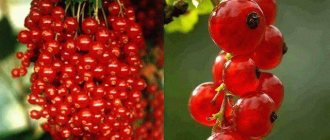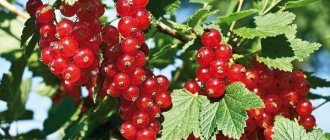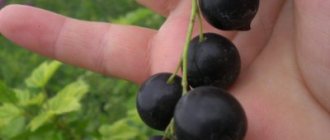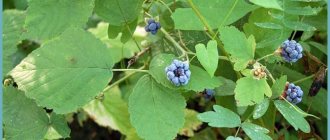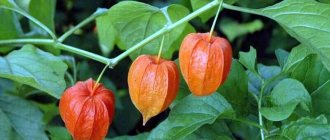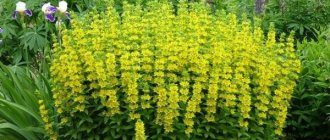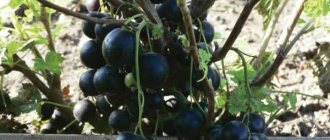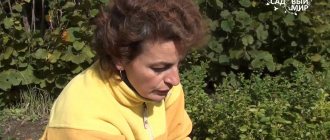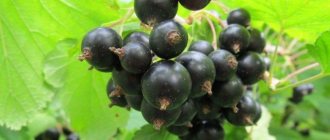Feeding
If before planting the seedling, the planting hole was well filled with organic and mineral fertilizers, then the currants do not need to be fertilized before fruiting begins. An indicator of a sufficient amount of nutrients is good shoot growth.
Fruiting currants consume a lot of nutrients. In the fall, under each bush I add 100-120 g of superphosphate and 30-40 g of potassium sulfate. I apply nitrogen fertilizers (40-50 g of ammonium nitrate or urea) in early spring before mulching the soil with rotted manure. The first time I feed it immediately after flowering with an infusion of bird droppings (1 bucket of droppings per 18-20 buckets of water), and sometimes with mullein infusion (1 bucket of organic matter per 5-6 buckets of water). I add a half-liter jar of ash to each bucket of infusion. I pour 1 bucket of prepared fertilizer under each bush.
Black currant responds with a good increase in yield to foliar feeding with microelements. I do the first fertilizing before flowering. In 10 liters of water I dissolve 20-30 g of urea, 7-8 g of boric acid, 1 g of zinc chloride, 0.5 g of copper sulfate (copper sulfate) and 0.3 g of potassium permanganate. I fertilize in the evening in calm weather.
I do the second foliar feeding during the formation of ovaries with a mixture of 0.5% urea solution (50 g per 10 l of water) and 2% superphosphate solution.
“Garden for the soul and good rest”, No. 9, 2014 (Nizhny Novgorod)
Care
The main care for pink currants consists of watering, fertilizing and treating against diseases and pests. In addition, you need to remove weeds and loosen the soil.
You can learn about planting currants in the fall here.
Watering
Pink currant is a moisture-loving plant and develops well when the soil is well moistened. During the growing season, currants need to be watered at least 4 times. In very hot weather, the plant should be watered once every 7 days, spending at least 40 liters of water per bush. It is recommended to dig a shallow ditch around the bush for irrigation and make a border of soil. Sprinkling is very useful for currants, which should be done regularly in dry weather. The last time currants are watered is in the fall after the leaves fall.
Feeding
Currants respond well to the use of mineral fertilizers. Colored varieties of currants should be fed four times during the growing season. During the first spring feeding, 10 grams of dry nitroammophoska are applied to the bush. During the flowering period, 10 grams of superphosphate and 8 grams of potassium sulfate are dissolved in 10 liters of water and this mixture is poured under a pink currant bush. During the formation of the ovary, 200 grams of wood ash can be used as a top dressing. After harvesting, the same solution is used as during the flowering period.
Why currants turn yellow can be found here.
Description of the variety
“Dutch Rose” is one of the old Western European varieties that has not lost its popularity in our time. Its origin is unknown to breeders. Many gardeners consider this variety to be the best analogue of ordinary, wild currants. Here is a brief description of the parts of the variety:
- Bush. Late-ripening, frost-resistant plant. Bushes reach a height of up to 1500mm. The crown is not spreading, with unthickened stems - this quality allows the sun to evenly illuminate all parts of the bush and ensures the simultaneous ripening of fruits and their harvesting. Young, hairless shoots are straight, thick, green in color with small red spots. Then their color changes to light brown. The bush begins to bear fruit 2 years after planting.
- Foliage. The leaves are painted in a delicate green color, they have a three or five-lobed structure. The surface is smooth, the outer side has a shiny surface. The inner part of the foliage is lightened in color, along the veins with slight pubescence.
- Colors. Medium size with a saucer-like shape. The sepals are greenish in color with small patches of yellow and red specks. Fruit and flower buds are located on the upper sections of annual growth - therefore, when rejuvenating pruning, the gardener should not cut off the tops of the branches.
- Yagod. The shape is round. The size of the berries of this variety is one of the largest; with proper care, the fruits develop to a weight of 1.1 g. The average weight of the fruit is 0.9 g. Some gardeners grow berries the size of cherries, weighing up to 2 g. The berry is thin and tender skin, seeds are very small. The brush grows up to 140 mm and up to 15 pieces of pale pink, sweet and juicy fruits grow on it in a dense group.
Advantages and disadvantages of the variety
Let us list the main advantages of this type of currant:
- high resistance to negative temperatures, but does not tolerate sudden changes in weather, especially glaciation;
- shrubs are not susceptible to pests and a number of diseases, but this will require all maintenance work and preventive treatments;
- high rates of yield and size of berries.
The disadvantages of the variety include:
- susceptible to fungal diseases. At the first signs of manifestation, the plants are immediately treated with fungicides, and the affected shoots or foliage are removed from the site;
- slow growth and development of bushes;
- insufficient sugar level.
This is interesting: Currant Exotic: let's look at the points
Features of planting work
Before starting work, a novice gardener will need to familiarize himself with the recommendations for carrying out preparatory measures and planting seedlings in open ground. Let's look at these questions in more detail.
Selecting a location
This type of plant can grow and develop normally in any conditions, but to increase productivity and extend the fruiting period of shrubs, it is better to choose a place for them, taking into account several rules:
- currants develop freely in sunny areas, with a minimum lighting time of up to 12 hours;
- It is better to plant the plants in a dry area with loose and soft soil. If this is not possible, you will have to prepare the soil before planting the plant. To do this, mix manure and compost in equal parts and spread it evenly over the soil before digging in the fall. Per 1 m2 you will need to add up to 60 kg of nutrient solution;
- currants do not like areas with high levels of soil acidity. It’s easy to lower this level to normal; just add 200 g of quicklime per 1 m2 to the soil;
- the plant reacts poorly to places with constantly blowing winds and drafts;
- It is better to plant shrubs along paths or fences.
Landing dates
The best planting time is autumn. During this period, it is easy for the gardener to determine the quality of the seedling by the condition of the foliage and roots. In the fall, nurseries sell off the bulk of the planting material, leaving only unsold plants for the spring. You can read about choosing a seedling in a separate chapter of the article.
In the fall, the planted bushes undergo natural stratification (the plant is treated with cold) and when the first warm days arrive, they begin to develop quickly, much faster than the seedlings planted in the spring.
But in the first winter, plants need to be protected from frost. To do this, we wrap the plant with covering material, old Lenolium or roofing felt. This protects the unrooted, weakened bush from frost, and the succulent, young shoots from hares and other lovers of delicate bark.
Site preparation
For the preparatory stage, this is one of the most important works. This is how we provide the currant roots with nutrients and ensure normal distances between the bushes for their ventilation and lighting:
- At a distance of up to 2.5 m from each other, we dig planting holes with a diameter of 400-450 mm and a depth of up to 500 mm. We put the top fertile layer of soil aside.
- We carefully loosen the soil from the hole and mix it in equal quantities with humus or compost. We add mineral fertilizers to this composition:
- superphosphate – 200-250 g;
- potassium permanganate – 40 g;
- sifted wood ash – 300-400 g.
- If the soil in the area is wet, place a layer of good drainage on the bottom of the hole. To do this, we use broken bricks, crushed stone or old crushed bricks. The thickness of the denage layer is from 100 mm, but its value must be taken into account when determining the depth of the hole. Mix the nutrient solution thoroughly and pour it completely into the hole.
- Fill the hole with up to 30 liters of water and leave it for 14 days. During this time, the nutrients will dissolve in the soil.
Selection of seedlings
If it is not possible to grow your own planting material or simply divide a strong bush into several seedlings, you will need to buy the plant in nurseries or from trusted sellers. It’s better to go to the nursery to pick up the bushes, where you can choose a plant directly from the school.
What is important to pay attention to when choosing currants:
- Level of development of the horse system and its condition. If the rhizome has a branched system of roots with many buds, you can safely buy such a bush. The root system consists of 1-2 roots, or the roots have an unhealthy appearance with signs of damage by diseases or pests, or the roots are dry and brittle - it is better not to buy such a seedling even for very ridiculous money.
- We pay attention to the treatment of the roots after they are shortened. If the roots are not treated with ash or varnish, the seller did not take care of the seedlings and the roots could dry out.
- Level of flexibility and condition of shoots. If there is any foliage left on the bush, you can easily identify the seedling from it and what type of currant the seller is trying to sell you. It is so easy to distinguish black currants from the rest, even without knowing the structure of the foliage. Simply rub the leaf and if the genuine aroma of blackcurrant spreads, they are trying to sell you a low-quality seedling. The shoots should be thick, flexible and juicy. Another indicator is the color of the shoot; it should be green with a slight yellowish tint.
- The shoots should not have any traces of pests or diseases - such seedlings will 100% not bring fungi or infections and pests into the garden.
It is not recommended to plant plants on a hot day. It is better to do this in cloudy or cloudy weather without strong wind. We carry out all work in several stages:
- we take the prepared soil to a depth greater than the length of the rhizome. It is better to lay out the soil on film;
- in the middle of the hole we pour a small mound, place a seedling on it and carefully straighten each root, distributing the roots throughout the circle;
- We begin to fill the rhizome with loose soil. When the hole is completely filled, carefully compact the soil around the plant with your foot;
- pour 20-30 liters of water onto each bush in small portions;
- after the water has been saturated, fill the hole and the ground around with a layer of mulch;
- We cut off young shoots at a distance of 150 mm from ground level, this way we ensure the development and survival of the root system. The shoots will begin to grow in the spring, receiving nutrition from the strong rhizome.
Planting pink currants
Pink currants, unlike, for example, the black variety, are considered a more hardy and unpretentious crop. Let's consider the key rules for planting this berry crop.
Place and time of planting pink currants
- The best time for planting pink currants is the first half of autumn, when the seedlings have time to fully adapt and take root in a new place, before the onset of winter cold.
- When choosing a place to plant pink currants, you need to choose sunny areas, protected from open gusty winds and drafts. The yield of the crop will directly depend on these factors, since in the shade the berries ripen small and not so sweet.
- As for the soil, the best options for currants are chernozem loams, although the crop can grow and develop quite successfully on other types of soil. The main condition is light, fertile, moist soil with a neutral or slightly acidic reaction environment. If there is a lack of nutrients in the soil, pink currants may drop some of the fruits that have set.
- You should not plant shrubs in lowlands or damp, often flooded places. Such a location provokes rotting of the perennial currant roots.
Agricultural technology for planting pink currants
- Before you start planting a shrub, prepare a place for its planting. The soil is dug up, weeds are removed, and a planting hole is dug.
- If the soil is poor, you should definitely add organic fertilizers to the planting hole: manure, humus, wood ash or compost. Organic matter is mixed with soil, forming a fertile bottom layer in the hole. Such preparatory work is usually carried out 2-3 weeks before planting the seedling.
- In addition, pink currants respond well to potassium - phosphorus fertilizers, which can also be placed in the soil when planting a perennial (while digging the site). For this you can use, for example, potassium sulfate and superphosphate granules.
- The diameter of the planting hole, by and large, depends on the size of the root system of the seedling. On average, the parameters of the pit are about half a meter, both in width and depth.
- The seedlings are planted at a slight slope (at an angle of 45), thus ensuring the formation of a spreading shrub with a large number of shoots. With such planting, flower buds are formed on all shoots of the same age, which means the yield increases several times. When planted correctly, the root collar of the shrub is buried 5-7 cm into the soil.
- After planting, the soil is compacted, and the bush is watered abundantly, after which the shoots are pruned, leaving no more than 15-20 cm from the ground (leaving 2-3 buds). The tree trunk circle is mulched with straw, peat or humus. During the dry period, 2-3 days after planting, watering the seedlings is repeated.
- If several currant bushes are planted, the distance between specimens should be at least 1 meter (and for vigorous varieties, at least 1.5-2 meters). Otherwise, the growing clumps will simply shade each other. Each bush should be well lit and have sufficient nutrition area. If currants are planted in rows, it is recommended to maintain a row spacing of 2-2.5 m, and the distance between bushes in rows is 1.2-1.5 m.
- Currants are a self-fertile crop (does not require pollination by insects), but additional pollination from other currant varieties can play an important role in obtaining good, stable yields.
Reproduction methods
To propagate pink currants, use one of the following methods:
- seed;
- cuttings;
- layering;
- dividing the bush.
The most effective, simplest method of propagating Dutch red currants, according to gardeners, is cuttings, which is also used for other types of red currants. Annual cuttings are taken from strong, developed branches and planted in a planting bed. Regularly moisten the soil, loosen it and, after rooting, plant it in a permanent place. For layering, elastic shoots are chosen, which are bent to the ground in pre-dug holes. They are fixed with metal staples and the tops are tied to the pegs vertically. By autumn, the cuttings are transplanted to a permanent place. If it is necessary to replant plants, use the optimal method of propagation - dividing the bush. They are carefully dug up after abundant watering, the root system is divided into several parts with a sharp knife and planted in a new place. Seedlings with young shoots take root best.
Diseases and how to deal with them
Modern varieties and hybrid forms of white are resistant to infection by diseases and pests. More often, problems arise when planting is too dense, care rules are not followed, and water stagnates in the soil. As a preventive measure, routine treatment of shrubs and soil with a systemic fungicide should be carried out. Opening hours: early spring and autumn. For the treatment of fungal infections, copper-containing preparations, for example, Bordeaux mixture, Hom and Oxychom, demonstrate effectiveness. In addition, old and deformed shoots and vegetative parts with signs of infection should be systematically pruned.
Whitefly
A harmful butterfly whose body length does not exceed 3 mm. It got its name because of the white color of its wings. Often found in regions with warm and humid climates. Both adult insects and their larvae pose a danger to the currant bush. They infect leaves, shoots and roots, and feed on plant sap. This leads to a deterioration in metabolism and a slowdown in photosynthesis. It may happen that the bush stops growing and bearing fruit and gradually fades.
We recommend that you familiarize yourself with the best varieties of currants for Siberia in this material.
To combat whiteflies, chemical insecticides with contact and systemic action are used. For treatment, you can use Aktara, Iskra, Actellik, Intavir. Spraying of soil and bushes is carried out twice, the interval between procedures is 10 days.
Gray rot
The causative agent of the disease is a pathogenic fungus found on plant debris. The plant may look sick. Able to endure cold winters, has endurance to external factors. The infection can be determined by the withering of the shoots of the first year of growth. A gray coating appears on the leaves, gradually growing throughout the entire blade. For prevention, you need to prune and clean up leaves after picking berries. For treatment, traditional methods are used (soap solution, soda ash), chemicals (copper sulfate, Bordeaux mixture, Khom). Spraying should be carried out in two stages with an interval of 10-14 days.
Why does the bush turn white?
The appearance of a white coating on the leaves and shoots of currants can be a sign of various types of problems. More often it indicates that the plant is infected with powdery mildew. This is a fungal infection that affects all vegetative parts and leads to the death of the bush within 1-2 years. It responds well to treatment; to combat the disease, treatment with fungicides with a high copper content is used.
The second common reason why a plant may turn white is a lack of magnesium in the soil on the site. As a rule, it is observed when growing crops on a clay or peat substrate. What to do about it? The problem can be eliminated by applying mineral fertilizer, for example, potassium magnesia at the rate of 10 g per square meter. meter.
Reasons why it may crumble
Shedding of flowers is a common cause of reduced yield of white currants, which must be combated. The problem may be caused by one or more unfavorable factors. The following provoking conditions are identified that may cause white currants to fall off:
- excess or lack of potassium in the soil;
- growing a plant on an excessively wet substrate, stagnation of water in the soil;
- damage by fungal or viral diseases;
- infestation with pests (bud and spider mites, thrips);
- non-compliance with the rules of care, watering and fertilizing regimes;
- growing old bushes over 15 years old.
Insecticides are used only when traces of harmful insects are detected. It is advisable to apply mineral fertilizer, for example, nitroammophoska at the rate of 20 g per square meter. meter.
Why is there no ovary
The absence of fruiting is normally observed in the first 2-3 years of plant growth. Then the sign indicates the presence of diseases or problems with care or soil composition. Reasons why ovaries do not appear on currants:
- lack of potassium in the soil;
- infection of the bush by diseases and pests;
- prolonged drying out or waterlogging of the soil;
- low-quality planting material, plant age over 15 years;
- there are no pollinators in the immediate vicinity (not self-fertile currants).
You can find a list of the best blackcurrant varieties for the Urals here.
Ovaries form on the plant a few days after the final formation of flowers. If the berries do not develop, you will not be able to get a harvest this season. Experienced gardeners recommend that in such a situation, complete pruning of the bush or replanting it to a new location.
Growing
Planting and growing Dutch red currants is a simple process. Regardless of the variety chosen, it is enough to follow the general rules.
Selecting a location
- Since this crop is light-loving, it is necessary to give preference to a well-lit, sunny area, preferably on a southern slope.
- Suitable soil type is loam, chernozem with neutral acidity, slightly acidic or sandy loam soil.
- Choose planting material that is 1-2 years old, with a well-developed root system at least 20 cm long.
Important! When preparing seedlings for planting, it is enough to remove all the leaves and soak the roots in water for 2-3 hours.
Landing dates
It is best to plant red currants in the fall - seedlings that are planted in September take root best. If there is a need to plant in the spring, then do it in mid-April.
Landing technology
- Prepare the hole in advance - 2-3 weeks before planting. The dimensions of the holes are 50-60 cm in diameter, the optimal depth is 40 cm. The distance between the holes when planting several shrubs is 1.5-2 meters. When planting near fences, you need to make the same indentation from them.
- Mix the excavated soil with peat or humus in an amount of about 8 kg, add to it 200 g of superphosphate, 40 g of wood ash or potassium sulfate.
- Immediately pour half of this mixture into the hole.
- When planting, straighten the roots of the bush well, deepen the root collar by 5-6 cm, and fill the hole with the remaining soil mixture.
- Compact the soil well, water at the rate of 1 bucket of water per bush, create a layer of mulch from peat or humus.
- Trim the shoots at a height of 10-15 cm, leaving up to 3 buds on each branch.
- Water the seedling 2-3 times a week until it takes root.
Important! If you plan to plant red currants in the spring, then the same procedure is followed. The only difference is that the pits are prepared and organic fertilizers are placed in them in the fall, and potassium-phosphorus fertilizers are applied immediately before planting.
Appearance, characteristics of berries, ripening time, yield
The variety is early ripening (ripening period - July). The plant form is deciduous shrub. The bush is medium-sized (0.9–1.2 m), spreading (crown diameter - 1 m), densely leafy. Young shoots are straight, vertical, pinkish along the entire length, slightly pubescent, annual growth is 60 cm. Old branches are lignified, straight, light brown.
Read about the Dutch pink currant variety.
The berries are dense, one-dimensional, pink, translucent. Fruit weight is 0.9–1 g, size is about 8–10 mm in diameter. They ripen in July 70 days after pollination. The separation is dry. The peduncle is medium, light green, thin. The berries are located in drooping clusters and do not fall off when ripe. Under favorable conditions, during the growing season and with fewer fruits in the bush, the berries are larger, since competition for nutrients is eliminated.
The skin is thin, transparent, the flesh is juicy and aromatic. The taste is sweet, dessert. Universal use. Berries are highly valued as a decoration for desserts. The variety is fast-growing, with simultaneous ripening of berries. It begins to bear fruit in 1-2 years, reaching maximum yield by 3-4 years.
Productivity - 4–6 kg of berries from each bush. Under the weight of the berries, the branches may lie down and the shape of the bush may disintegrate; in such cases, supports and tying of the stems are necessary.
Currant Pink pearl is a self-pollinating variety, that is, a pollinator is not required and one type is sufficient for the formation of ovaries, but the presence of a second variety nearby and the flight of bees and insects can improve the quality of pollination and increase productivity. The plant is a good honey plant.
The variety is characterized by high resistance to low temperatures (zone 4), diseases and pests. Flowers and ovaries may be damaged by spring frosts.
Assuming that pink currants are closer to red ones, we can assume that the composition of biologically active substances (per 100 g of fresh berries) in these varieties is approximately the same:
- calories - 56 kcal;
- proteins - 1.5 g;
- fats - 0.2 g;
- carbohydrates - 14 g;
- mono- and disaccharides - 8.3 g;
- water - 85 g;
- ash - 0.6 g;
- dietary fiber - 4.8 g.
Berries are a good source of various phytonutrients, vitamins and minerals. Pink currants are rich in vitamins A, B, C (49% of the daily value) and potassium K (10%). It contains more vitamin C and antioxidants than oranges. Potassium is a mineral that is essential for all cells in the body, especially muscle tissue and the heart. Being a good source of fiber, pink currants improve digestion.
Read all about the health benefits and harms of white currants.
Advantages of a Dutch beauty
The advantage of Dutch pink currants is that they can easily tolerate low temperatures and not freeze during the cold season. But sudden changes in temperature can negatively affect berry bushes.
What else is characteristic of this variety? The plant resists all kinds of pests and is not affected by a number of diseases. But currants are powerless against fungal disease. If you notice a change in the color of the leaves with the appearance of burgundy spots on them, then this is a fungus. Such leaves must be immediately removed from the branch, since when moisture appears they will continue to spread throughout the currant bush.
The best varieties of white currants
Varieties should be selected depending on their geographical location. If the hybrid variety is less susceptible to disease, it will not be able to survive even minimal frosts.
Moreover, the gardener will be able to control the time of harvest and the size of the berries. Experts have developed several new species that will allow you to harvest healthy berries before anyone else.
Large varieties
Today we can distinguish individual varieties that are not prone to diseases and produce a bountiful harvest of large berries:
- White English is a quality variety that is used for commercial purposes. The berry turns out juicy and sweet. Retains its aroma even after heat treatment.
- Belaya Belyana - with proper care, produces a plentiful and early harvest of large berries. The main distinguishing feature is that the variety is sweet and very tasty. The plant survives frost well.
- Large white - if the gardener has little free time. The plant will produce a stable average yield of large berries with minimal care.
currant variety "White English"
currant variety "Belaya Belyana"
currant variety "Big White"
Sweet varieties
Sweet varieties are used to prepare fruit drinks, juices and wines. In this case, the size of the berries does not matter, the main thing is that they are aromatic and honey-like. Today there are 3 most effective hybrids that are suitable for growing in any territory:
- Versailles white - the berries are small and cream-colored. The variety is ideal for wines and fruit drinks. The plant does not require constant care and has good immunity.
- Dutch pink – good for fruit drinks. The berries are sweet and have a pleasant sourness due to the vitamin C concentrate.
- Dessert - the name speaks for itself. The sweetest variety, high and abundant harvest. When properly fed, it has a pronounced honey taste.
currant variety "Versailles white"
currant variety "Dutch pink"
currant variety "Dessert"
Early varieties
Every gardener dreams of getting a harvest before everyone else. However, such plants are often whimsical, and the harvest barely survives until the beginning of September. In order to please yourself with high-quality and beautiful bunches throughout the season, you can choose the most effective variety:
- Ural white - does not require constant care. The plant has exceptional immunity and survives the winter well.
- Jumper is a tall and strong bush. The variety is often used for design purposes. However, the plant has good fertility and resistance to insects.
currant variety "Ural white"
currant variety "Prygazhunya"
Medium varieties
Medium varieties rarely boast an abundance of yield and a bright flavor. However, these are the plants that need the least care; they have a well-developed immune system and rarely get sick. The main varieties include:
- White Potapenko.
- White Fairy.
- White Boulogne.
currant variety "White Potapenko"
currant variety "White Fairy"
currant variety "White Boulogne"
The branches are resistant to natural disasters. The plant will withstand harsh winters and plenty of snow. The yield, although average, is often due to good immunity, the plant produces more than large varieties. For those who do not have the opportunity to visit the plant throughout the entire period, this is an ideal option.
About history
Dutch red currant, which is described in many reference books, belongs to the ancient Western European varieties. True, the history of the appearance of this species is not completely known. It is well known that the plant came to our country from Holland. It is not clear where the currants were brought to Holland from. Some claim that the variety was bred in the Netherlands. It is only known that it is a direct descendant of ordinary currants. Thanks to its taste and ease of care, the bush has gained popularity among summer residents.
Dutch pink currants will decorate any area
Description of colored currants
The homeland of currants is Europe and Siberia, which is why it feels so at home in our gardens. Wild currants can be found in the mountains, in forest clearings, and in bushes. The fruits contain vitamins C, A, B1, B2, PP, K, E, microelements, acids, pectins.
Cauliflower currant is a small deciduous shrub of the Gooseberry family. The red and white species have the same developmental biology, but slightly different from the black biology. White is a variety of red and differs from it only in the color and taste of the fruit.
The distribution area is in the forest zone throughout Eurasia, where it grows wild. It is found on forest edges, prefers the banks of rivers or streams, and forms thickets.
The root system penetrates the ground as deeply as that of the black species. Every year shoots grow from the base, the strongest of which are left to form a bush, the weak ones are removed.
The leaves are alternate, five-, three-lobed or entire. Fruit buds are numerous. On one-year-old wood they are located singly, and on two-year-old and perennial wood - in groups. The fruit bud, located in the leaf axil of an annual shoot, blooms in the spring and produces a flower cluster, and from it a fruiting ringlet subsequently develops, which lives somewhat longer than in black varieties. Both red and white enter the growing season before black. The fruit is a multi-seeded berry. It has a whitish or yellowish color, sometimes colored. The shape of the berry is round, oval and pear-shaped.
Berries contain sugar, acids, aromatic substances and vitamins. There is noticeably less of the latter than in black fruit, especially vitamin C. The fruits are used for fresh consumption, as well as for making jam, juices, marmalade, jelly, etc.
Perennial shrubs are more durable than black currants. They can live 25-30 years. The harvest under favorable conditions can reach 20 kg, sometimes 25-30 kg, and the bushes can bear fruit for a maximum of 20 years. Horizontal roots are located in a layer of 30-40 cm, and vertical ones penetrate to a depth of 1.2 m. The first harvest can be collected from three to four year old bushes, and then the yield increases every year. In the 9-12th year after planting, currants reach their peak yield, and by the age of 15 they “get tired” and the yield noticeably decreases.
The color of the berries ranges from pure white, through pink to dark red, and its most important difference from black currants is the absence of a specific smell in the leaves and berries, but the main thing is that the berries, even when ripe, do not fall off for a long time and can decorate the garden until frost.
It can be planted along the boundaries of the site along a low fence, retreating from it by 1-1.5 m, or along paths. This will be especially convenient if you later form the bushes in the form of a flat trellis. The distance between bushes depends on their size in adulthood. Plants with compact, upright crowns can be planted every 1.25 m, and large, spreading bushes - after 1.5. Otherwise the placement is similar to blackcurrant.
Harvesting
In the description of the “Dutch pink” currant variety, you can add that with good care you can collect up to 9 kilograms of delicious berries from one bush. This is a very good indicator, which distinguishes it favorably from other varieties of currants. To do this, it is necessary to regularly cultivate the soil, fertilize the soil in the spring and water it. Then you can achieve good results. If you do not feed the plant, the harvest will have the following indicators: 3-5 kilograms per bush.
You can pick ripe berries only in mid-summer, which is closer to the end of July. It is generally accepted that currants of this variety bear fruit late. But its berries retain their aroma and freshness until golden autumn.
You can taste the fruits both fresh and after heat treatment. The collected berries will perfectly complement the composition of a summer fruit salad or serve as a decoration for dessert. What’s noteworthy is that Dutch pink currants are rich in vitamin C, so eating them fresh will have a beneficial effect on your health.
And if you love home canning, then jams, jams, syrups, jellies and compotes will give you a piece of summer on cold evenings and charge your body with vital energy. Interestingly, the berries do not retain their delicate pink color after undergoing heat treatment.
Currants are valued among gardeners and gardeners not only for their beneficial qualities, but also for their ease of care. There are a lot of varieties of currants; one of the most common and popular options for our area is Dutch pink currant.
Varieties
A large number of varieties and hybrid forms of pink currant have been developed. They differ in yield, ripening period and taste of the fruit. When choosing a seedling for your garden, you should take into account resistance to diseases and climate, as well as the characteristics of the plant itself to form an effective planting.
A list of varieties resistant to bud mite can be found here.
Rossoshanskaya
The variety was bred by domestic breeders in the Voronezh region. It is used, like the Leningrad Giant variety, for growing in regions in the temperate climate zone, but is also suitable for planting in the north. It has a medium late ripening period. The berries are large, with a pronounced dessert taste. The skin is bright pink and can become almost transparent in low light. The fruits grow up to 1.1 g, collected in large clusters. The plant is resistant to powdery mildew and anthracnose. Productivity – 4-6 kg per bush.
Jumping
A mid-late variety of table pink currant. Developed by breeders at the Belarusian National Academy of Sciences, the first tests were carried out in 2002. It is distinguished by large berries weighing up to 0.8 g. They have a uniform round shape, the pulp has a sweet and sour taste. The brushes are of medium length and rarely fall off when ripe. The shrub has high frost resistance and resistance to American powdery mildew. The plant, like the White Versailles variety, is self-fertile and does not require pollinators. The fruits tolerate long-term freezing without loss of taste.
wonderful
It is considered a rare variety; planting material is difficult to find on sale. The plant is represented by a powerful bush up to 1.5 m high. The berries are collected in clusters of 8-12 pieces. The skin is light pink, the flowers are fragrant and emit a sweet scent. Productivity – 7-8 kg per bush. Ripening earlier, the first harvest can be obtained at the end of July. The plant is frost-resistant and has strong immunity to diseases typical for the crop. The fruits are suitable for making jellies, wines and jams. This variety is grown according to the same scheme as the Consul gooseberry.
Pink nutmeg
Self-pollinating variety with an average ripening period. The fruits appear in the second half of July. Medium-sized shrub that tolerates shaping well. Like the Yadrenaya variety, it prefers sunny places; with regular darkening, the yield decreases. From one plant you can collect 4-6 kg of berries. They are colored light pink and may have transparent skin. During the entire growing season, currants exude a strong aroma of nutmeg. The fruits have a dessert taste and a universal purpose; due to their acid content, they are suitable for making wine.
Rosa tear
The pink currant variety Rosa tear has a medium early ripening period. Forms a slightly spreading bush with short branches. The berries are of a regular round shape, the skin is beige-pink. They can grow up to 0.8 g, the average yield is 6 kg per bush. The plant is resistant to septoria, there is average resistance to powdery mildew and anthracnose. The variety is demanding on the quality and composition of the soil; for cultivation it is recommended to choose only fertile places with loamy or sandy loam soil.
Pink pearl
Ribes Rose Pearl is a Canadian variety developed in the 80s of the last century. Fruiting earlier, the first harvest can be harvested by the end of July. The berries have a regular round shape, the skin is colored bright pink. Their average weight is 0.8 g, the yield per bush is 5-7 kg. The fruits practically do not fall off the branches, and there is no tendency to become infected with diseases and pests. Despite its frost resistance, the plant does not tolerate spring frosts well and requires shelter.
Dutch pink
A late-ripening variety that forms a compact and slightly spreading bush. This allows plants to be planted with minimal intervals, which makes maintenance easier without loss of yield. The berries are large, can grow up to 1.1 g. The skin is thin, colored light pink. The variety is popular due to its powerful resistance to fungal infections. Suitable for growing in regions with unfavorable climatic conditions, frost resistance is high. The pulp contains almost no seeds; the berries are recommended for making jams and confiture.
Lyubava
High-yielding hybrid of red and white currants. It has a mid-early ripening period and is suitable for planting in both southern and northern regions. The shrub has few branches, the shoots are dense and short. The berries are round in shape and colored pale pink. The average weight of the fruit is 0.9 g, the yield per bush is 5 kg. The plant tolerates frost and drought and is easy to care for. It is rarely affected by diseases typical of currants.
The best varieties of red currants for the Urals
| |
| Currants are propagated by dividing bushes, root suckers, layering, green and lignified cuttings, and tissue culture. |
| etc. |
| Recently, when creating new varieties of black currant, it is often crossed with closely related species - American currant ( |
I try to keep the soil under the currant bushes in a loose state during the summer. But since the currant roots are located close to the surface of the soil, I loosen it shallowly and carefully. After spring loosening, I always mulch the row spaces with a 5-6 cm layer of rotted manure, which helps retain moisture throughout the summer, prevents the growth of weeds and at the same time is a good fertilizer.
After spring loosening, I always mulch the row spaces with a 5-6 cm layer of rotted manure, which helps retain moisture throughout the summer, prevents the growth of weeds and at the same time is a good fertilizer.
Grace
Most varieties are self-fertile and harvests can be obtained with just one plant. Planting several copies helps to significantly increase the amount of harvest.
Main criteria for selection
When choosing a crop such as red currant for the Moscow region, first of all, attention is paid to the ripening time. If the variety is late-ripening, then in the northern regions you may not get a harvest at all
Therefore, taking into account the climate, choose the type:
- Early varieties produce harvest from mid-June to mid-July;
- The berries of mid-season varieties begin to ripen in the 2-3rd decade of July, but currants are larger and sweeter;
- Late varieties ripen only in August. The berries of these varieties are the sweetest.
When choosing red currants for their farm, most gardeners focus on yield indicators. And this is fair, because everyone wants to get the maximum amount of tasty and healthy berries so that they have enough to eat in the summer and stock up on for the winter.
On a note. The most productive varieties include the Dutch Red, Rondom, Marmaladnitsa, Yuterborgskaya, and Sugar varieties.
Contraindications for eating white currants
Due to the abundance of vitamins in its composition, exacerbation of allergies to one of the groups often occurs. Therefore, before use, you need to check with your therapist whether you have an intolerance to vitamins A, B, and C.
Despite this warning, there is no need to be afraid of negative effects on the functioning of the body. Experts only highlight some cases where eating a large amount of berries leads to a negative result:
- digestive diseases - due to the large amount of acids, stomach ulcers can be aggravated;
- general intolerance - extremely rarely observed in young children.
If you consume white currants in moderation, there will be no negative consequences. It is worth knowing a sense of proportion even when drinking homemade tincture or wine.
Pink currant. How to water?
Watering is the main stage of caring for currants. Must be timely and sufficient. But you shouldn’t water to reserve. Stagnant water has a detrimental effect on the crop. Autumn, proper care will allow you to have an excellent harvest next season. Do not forget about loosening and weeding from malicious weeds. Because they can cause various diseases. They will also be an excellent shelter for pests during the winter.
Pink currants love moisture. Development will be gradual, the plant will be healthy. And, accordingly, the long-awaited harvest will please you with its quantity. Good moisture is the key to proper plant development. But you shouldn’t do it very often. As a rule, 5 waterings are enough during the summer season. It is taken into account that summer is not without rain.
If the summer is very hot, watering needs to be done more often. As a rule, once a week. 40 liters for each bush. Another type of irrigation is sprinkling. The process is very important for currants. In cases where rain is a rare occurrence during the season, carry out regular artificial sprinkling. After the last harvest is harvested, the foliage begins to fall en masse. Water each bush deeply for the last time for the season.
Fighting currant bush diseases
The only pest against which Dutch pink currants are powerless is aphids. It is located in colonies on the bottom of the leaf. Tubercles are formed in these places, which can be red or yellow. To prevent this pest from settling on the currant bush, it is necessary to timely treat the soil against weeds, remove the entire diseased branch from the bush and irrigate the currant with boiling water if it has been attacked by aphids. But this can only be done in the warm season to avoid temperature changes. Because it is detrimental for her.
